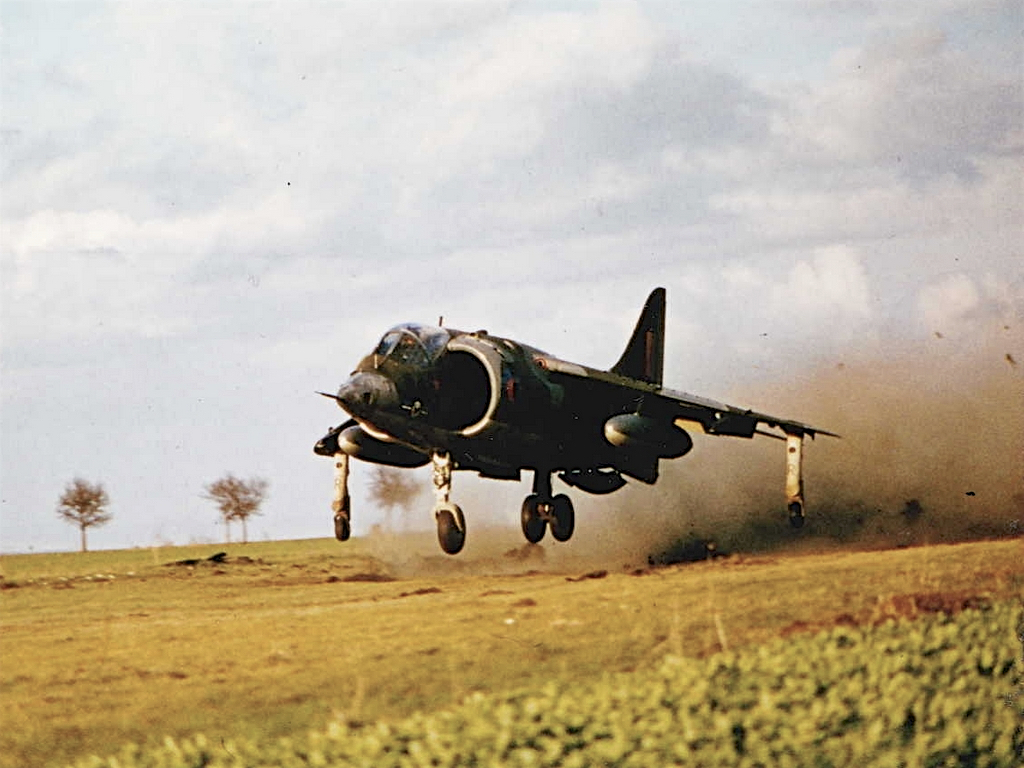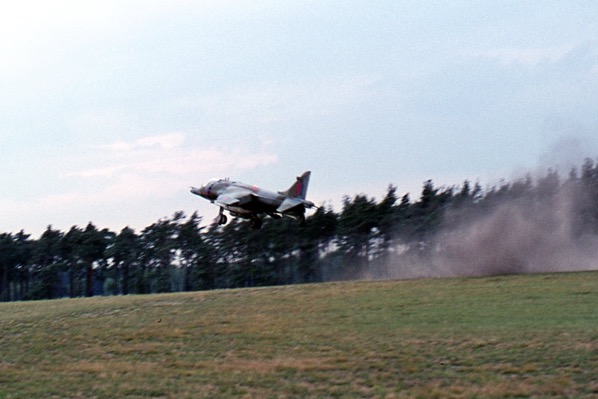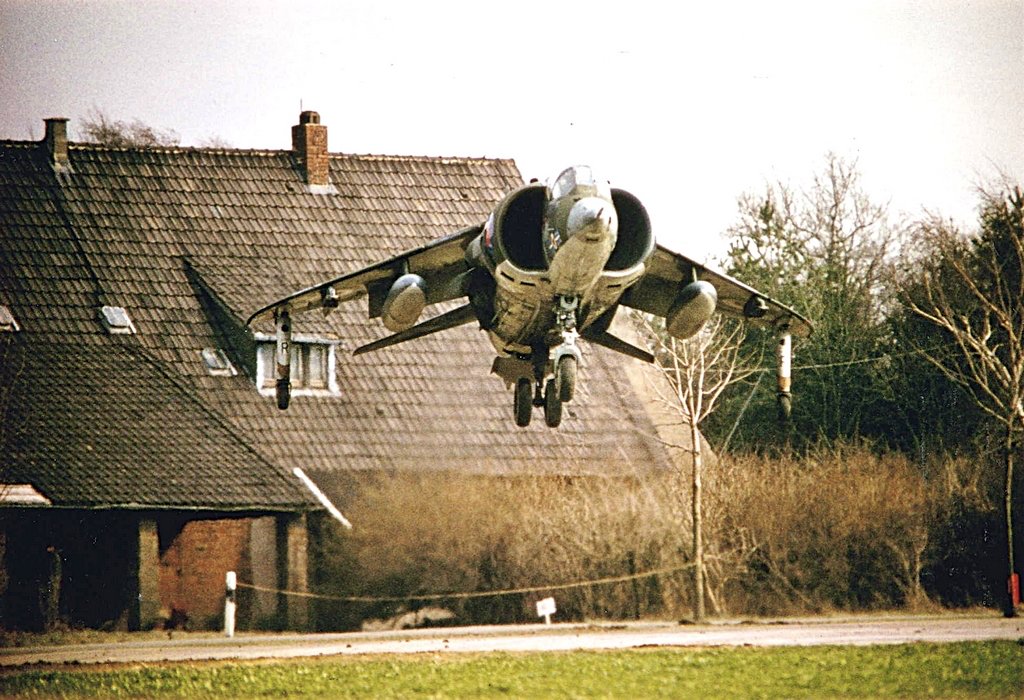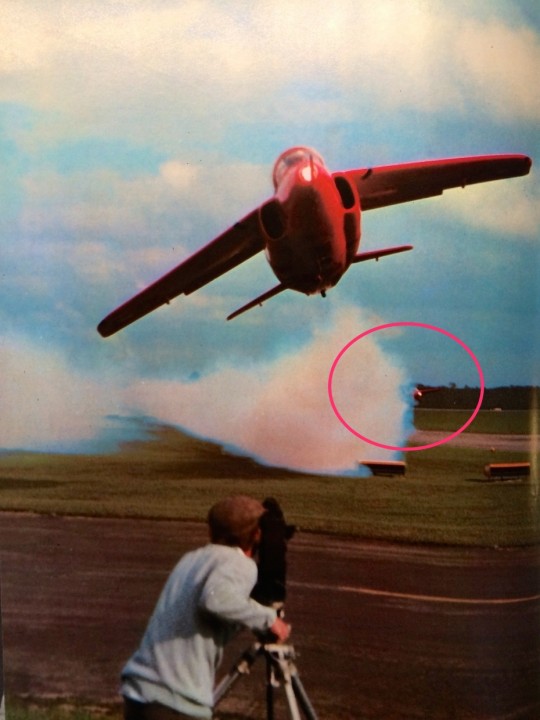Al Holman has kindly sent me some of his memories of field deployments with the Harrier Force in the 1970’s. Al flew the Harrier GR3/T4 on IV(AC) Sqn at Gutersloh from 1977 to 1980. I arrived on IV in November 1979 and remember sitting in the back of a T4 with Al performing an air test. Actually, I only remember holding on tight as we hedge-hopped across the North German plain…
Anyone who has been a part of the Harrier Force will without doubt have some very fond memories. It was quite a unique world to be part of operating an aircraft that was a fighter and a helicopter rolled into one – well almost!
The most enjoyable times were to be had when “Deploying to the Field” or on some rather soggy occasions “Mud Moving”. I was lucky enough to be around in the early days when we deployed up to 6 times a year. This frequency was reduced in later years as the preparation for such events was quite involved. Nonetheless, sometimes when the Station hooter sounded, maybe for a station exercise or a NATO tactical evaluation, we would deploy the whole shebang with no prior preparation. I remember on one occasion, just slicing the joint of beef, when that loud haunting sound became apparent. As it was a Sunday I said to my wife that it would just be a call out and I should be home again in a couple of hours. How wrong could I be as several days later, having deployed to a field site, and having moved location, we finally arrived back at camp somewhat weary. I rushed home to find the garden full of wives who were clearly making the most of their time without us!
A field deployment involved a myriad of personnel and I am not sure I could list them all as it involved so many. The Army engineers were needed to lay the metal strips, if they were required, and to lay the MEXE metal landing pad. In addition they installed the rubber fuel storage tanks. The RAF Regiment were our field defence unit. We needed engineers of all trades, photo reconnaissance interpreters, Army liaison personnel, headed by the Ground Liaison Officer (GLO), who were responsible for tasking the crew. We needed personnel for spares, refuelling, cooks, medics, signals and more. And of course we needed the pilots to fly the missions. In charge of all this was the site commander, a squadron flight commander.
Aircraft were generally landed vertically on metal pads and then taxied to the camouflaged “hide”. These were often on the edge of woods, sometimes inside the wood and sometimes hidden amongst buildings, particularly disused villages in and around the training areas. Tasking was often carried out using a telebrief system which connected the pilot by phone cable with operations, the GLO and with other aircraft if a multi aircraft mission was being planned. Normally each site would have 4-6 aircraft to operate. Briefings between pilots were mostly carried out whilst in the cockpit, as was planning. Trying to plot a route on a maps whilst in the rather restricted confines of a Harrier cockpit was not easy. Once ready the jets would be taxied to the take off area which was normally a grass field but sometimes a road.
Missions were varied from single aircraft reconnaissance tasks using either the built in port-facing camera or the centrally attached 5 camera reconnaissance pod. The pilot might be searching for troops and equipment in an area, on a road or at a known point. It might be a mission to report on the serviceability of bridges, masts ,barracks etc. There was often more than one target, which had to be found, photographed and a detailed report compiled for radio transmission to the in-flight reporting post. After landing the film would be rapidly downloaded and taken to the Reconnaissance Intelligence Centre for processing. How much easier it would have been if digital cameras were available. The pilot would be connected to the GLO for a debrief and then to the RIC to debrief with the Intelligence Officer.
Other missions flown would be single, pairs or even larger. “Mud Moving” missions to seek out and destroy such varied targets such as bridges, barracks, missile sites to moving targets known to be along certain routes of advance or in certain areas. The targets had to be located and then attacked with the weapon of choice. Of course in peace time it would have been rather unsporting to fire live ordnance so the attack was recorded on the head up display camera. This was then later assessed to ascertain if the attack had been successful. Once again an in-flight report was needed on the way home and after landing the pilots debriefed by telebrief with the GLO and amongst themselves.
All of these missions were normally around 40-45 minutes from take-off to landing so one can imagine how intense the workload could be. Added pressure was often introduced by other NATO aircraft being tasked to intercept and try and destroy, or at least foil, any target runs. It was all a great challenge and great fun.
After flying around 5-6 sorties the pilots gave up their warm and sweaty seat to another for his battering. Normally each aircraft would fly 10-12 sorties per day although on one occasion, due to some terrible weather, we only had one aircraft on the site for a few days. This had to operate solely from the MEXE pad taking off and landing vertically. Flight time was limited to 15-25 minutes and the site managed to launch the jet 20 times in a single day.
Photo: Barry Osborne
At the end of each day the personnel relaxed in the comfort of their 12×12 tent often playing cards to pass the time. The highlight of the evening was the meal which gave everyone on the site the opportunity to chat about the day’s events, amongst other things. Electricity was often in short supply so early nights were the norm as were early mornings. There was always a rush for the limited supply of hot water and most, including myself, would find themselves abluting in very cold water. Personal hygiene was not the best.
Morale was always high even though at times conditions were not the most ideal. I remember many periods of wind, rain and occasionally snow but morale was never dashed. To end the deployment site personnel often put on a concert using a 10 ton truck as the stage. There were some cracking acts from all ranks and trades.
As my experience level grew I became the deputy site commander, taking charge of the operation when my Flight Commander took his turn in the cockpit. We also took it in turn to set up the site and to dismantle it at the end of the deployment. I can’t remember the name of the site but it was my turn to wrap up the operation and my flight commander’s turn to lead the formation back to base. My Flight Commander at the time was dear departed Dave Binnie ex-Red Arrows pilot. It was normal practice for the departing aircraft to do a farewell flypast over the site before heading off. On this occasion the take-off was on a field, which had a row of trees at the back of the take-off point and a row of trees at the end of the take-off point. I placed myself about half way down the take-off field to watch the departure.
The aircraft departed normally and some minutes later made a beautiful flypast in box formation and then headed in the direction of base. I slowly walked back along the strip enjoying the lovely sunshine. It wasn’t long before the sound of a Harrier could be heard in the distance, but then the sound disappeared and I thought that it might be another aircraft from a different site. At the take-off end of the strip there was a gap in the trees just about big enough for a Harrier to fit through. Yes, you know what is coming. Out of the blue, and silently, came Dave’s Harrier pulling hard and with about 90 degrees of bank on. He passed through the gap and then aimed for me. I am not sure what happened for the next few seconds, but my next view was of a Harrier disappearing fast and low heading home.
The story continues as the next field deployment we were using a site, Geseke I think, that was based around a disused village. The aircraft were deployed around the buildings and for take-off we had to taxy across a local German road and onto the field strip. As one can imagine the operations did not go unnoticed by the civilian population and the normal quiet road became quite busy with “spotters”. Our police had a busy job controlling the numbers of civilian cars which, of course, were perfectly entitled to use their road.
At the end of the deployment it was my turn to lead the flock base to base and, as was the norm, we carried out a formation flypast of the site. As usual the Site Commander, one Dave Binnie, placed himself part the way along the strip to watch proceedings. After the formation flypast I split from the group and having previously scoped the layout decided to fly through a large gap in the trees which paralleled the take off strip. If I timed it right I would pass right over the Site Commander planning to give him a squirt of fuel. For those that don’t know the fuel jettison switches were on the right side of the stick so it needed a quick change of hands to operate them. Having always flown with my right hand it was not easy, at low level, to change hands, look for the jettison switches, operate them and then change hands again. As many, including myself, have since experienced the change to flying with the left hand is really easy to make only taking a matter of minutes for one to feel comfortable.
I concentrated now on passing overhead Dave who was striding down the strip towards the road crossing. In a matter of seconds I had passed him and I quickly switched hands to turn off the fuel jettison. My next recollection is of a large number of German civilian cars passing directly under the aircraft and I still had not managed to operate the jettison switches. Oops it was not a good error to make. I pulled up and away, finally managed to turn off the fuel jettison switches and rushed back to base wondering what news would be waiting for my return. For weeks I waited for the Boss to call me in to his office, but that call never came, at least not for this event!










Good to hear from you Al, As the 4 Sqn. 6 Site RIC Ringmeister(77-78) it is always a pleasure to see any of the “usual suspects” from those years posting in. I COULD write some 4 Squadron RIC stories of those happy days, but the basic conventions of security, libel and common decency perhaps prevent me. We P.I’s were generally young, highly motivated and supporting demanding missions flown by some of the best pilots in the RAF (or so they told me!). As a p.s., I live now in retirement on the North Tanzanian coast just south of Tanga and abeam Zanzibar. Always an en-suite room here for anybody fancying a few days in the region who wants to do a bit more than lie on the beach in Zanzibar. Cheers, Geoff ( a.k a. “Effing Quick!”, according to Tony Chaplin)
Hi Geoff – please send me some stories and photos!
Hi Chris Excellent anecdotes from Al Holman. My question is was he on 20 Sqn prior to 4 Sqn as most of his photos are of 20 Sqn jets? Also a great shot showing the Geseke facilities – I remember the place well, particularly the rat clearance in the buildings we carried out using Racasan in their boltholes, and an open hatch in the old Inn basement that you couldn’t see due to the floor being ankle deep in water. A bit of a shock when one of our ‘Chiefs’ walking in front of me suddenly disappeared down the hole – also full of water. Fortunately, he popped straight back up; if he’d gone, in any other direction than vertical he’d have been trapped in that chamber. So, arguably, the best vertical take off of the deployment! Cheers Pete. petemears@aol.com
Yes, pretty sure Al was on 20 then IV, although I saw the Sqn markings as 1 Sqn! Bah!
Webmaster: Will do . Give me a few days. Geoff.
From Dave Atkinson:
It was interesting to read the posts from Al Holman re the books and his 4 Sqdn period.
I was a Nav Inst mech on 20 at Wildenrath 1971 – 73 and have good memories of Flt Lt Holman as he was back then on 20. Al and his wife used to socialise with the ground crew at the Rugby Club etc but, if I remember correctly, they were told not to. He was one of the best and remember him being on TV down in the Falklands shortly after that conflict finished.
I wonder if he has contributed the events of his wheels up landing at Geseke in XW766? It was a 3 Sqdn jet on loan to 20 at the time and, after repair, it flew again 14 months later.